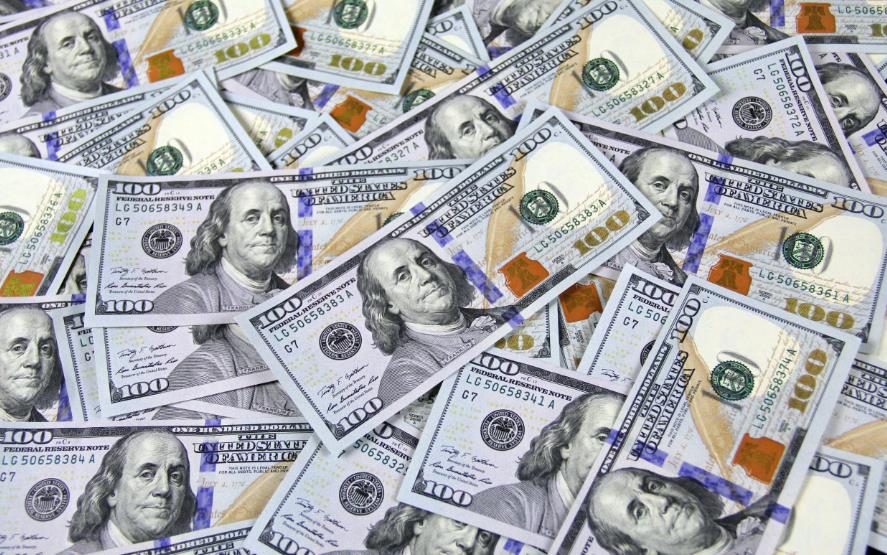The US dollar index, which measures the greenback against a basket of six major currencies, gave up some of its earlier gains on Friday after data showed that US producer prices unexpectedly fell in December. The decline in producer prices raised expectations of an early interest rate cut by the Federal Reserve, which could weigh on the dollar’s appeal.
According to the US Bureau of Labor Statistics, the producer price index (PPI) for final demand decreased 0.1% in December, following a 0.8% increase in November. Economists had expected a 0.4% rise in the PPI. On a year-over-year basis, the PPI rose 9.7% in December, down from 9.8% in November.
The drop in the PPI was mainly driven by a 0.7% decline in the index for final demand goods, which reflected lower prices for gasoline, diesel fuel, and fresh fruits and vegetables. The index for final demand services was unchanged in December, as a 0.4% rise in the index for final demand trade services was offset by a 0.4% fall in the index for final demand transportation and warehousing services.

The PPI excluding food, energy, and trade services, which is considered a core measure of producer inflation, edged up 0.1% in December, after a 0.3% increase in November. On an annual basis, the core PPI rose 6.8% in December, down from 6.9% in November.
The PPI data suggested that inflationary pressures at the producer level were easing, which could ease some of the concerns about the high consumer price inflation that has been plaguing the US economy. The consumer price index (CPI) rose 0.5% in December, slightly above market expectations, and 7% on a year-over-year basis, the highest since 1982.
Market Bets on March Rate Cut by Fed
The weak PPI data increased the chances of a rate cut by the Fed in the coming months, as the central bank has been signaling that it is ready to act if inflation remains persistently high and threatens the economic recovery. The Fed has already announced that it will speed up the tapering of its monthly bond purchases, which are expected to end in March, and has indicated that it could raise interest rates as soon as March or April.
However, the market seems to be pricing in a more aggressive policy stance by the Fed, as the Fed funds futures now imply a 79% probability of a March rate cut, up from 73% on Thursday, according to the CME Group’s FedWatch Tool. The market also expects two more rate hikes by the end of the year, bringing the Fed’s target range to 1.00%-1.25%.
“Even though you wouldn’t say overall that the macroeconomic picture is screaming at you that they need to cut that fast, the market seems to be excited about the prospect of cuts,” said Steve Englander, head of Global G10 FX Research and North America Macro Strategy at Standard Chartered Bank NY Branch.
Dollar Index Rises on Safe-Haven Demand
Despite the dovish expectations, the dollar index managed to rise on Friday, as it was supported by safe-haven demand amid rising geopolitical tensions in the Middle East. The US and Britain launched air strikes on Yemen overnight, in retaliation for attacks by Iran-backed Houthi rebels on Red Sea shipping. The strikes escalated the regional conflict that has been triggered by Israel’s war in Gaza.
The dollar index was last up 0.19% at 102.40, after hitting a two-week high of 102.58 earlier in the day. The index has gained 0.8% this week, as the dollar has benefited from its status as a reserve currency and a hedge against uncertainty.
The dollar was mixed against other major currencies on Friday. The euro, which is sensitive to higher energy costs, dipped 0.15% to $1.09555, after touching a two-week low of $1.09435. The British pound dropped 0.12% to $1.27470, after data showed that the UK economy grew slightly more than expected in November, but remained at risk of a mild recession. The Japanese yen, another safe-haven currency, rose 0.29% to 144.87 per dollar, as investors sought shelter from the market volatility.
The dollar also lost ground against some of the higher-yielding currencies, such as the Australian and New Zealand dollars, which were boosted by the prospect of lower US interest rates. The Aussie was little changed at $0.66870, after rising to a one-week high of $0.67050. The kiwi was up 0.22% at $0.62460, after reaching a one-week peak of $0.62600.
The Norwegian krone was another outperformer, as it gained from the higher oil prices that resulted from the geopolitical tensions. The US dollar was down 0.25% at 10.29 krone, after hitting a two-week low of 10.26 krone.
Bitcoin Slumps After SEC Approves ETFs
In the cryptocurrency market, bitcoin slumped more than 5% on Friday, after surging to a two-year high of $49,051 on Thursday. The rally was sparked by the news that the US Securities and Exchange Commission (SEC) approved the first exchange-traded funds (ETFs) linked to bitcoin futures, which could increase the institutional adoption of the digital asset.
However, the euphoria faded quickly, as some investors took profits and others remained cautious about the regulatory risks and the volatility of the cryptocurrency. Bitcoin was last trading at $43,643, down 5.4% on the day and 1.9% on the week.
